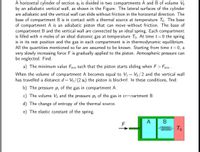
Elements Of Electromagnetics
7th Edition
ISBN: 9780190698614
Author: Sadiku, Matthew N. O.
Publisher: Oxford University Press
expand_more
expand_more
format_list_bulleted
Question
Please solve this problem asap .

Transcribed Image Text:A horizontal cylinder of section so is divided in two compartments A and B of volume Vo
by an adiabatic vertical wall, as shown in the Figure. The lateral surfaces of the cylinder
are adiabatic and the vertical wall can slide without friction in the horizontal direction. The
base of compartment B is in contact with a thermal source at temperature To. The base
of compartment A is an adiabatic piston that can move without friction. The base of
compartment B and the vertical wall are connected by an ideal spring. Each compartment
is filled with n moles of an ideal diatomic gas at temperature To. At time t=0 the spring
is in its rest position and the gas in each compartment is in thermodynamic equilibrium.
All the quantities mentioned so far are assumed to be known. Starting from time t=0, a
very slowly increasing force F is gradually applied to the piston. Atmospheric pressure can
be neglected. Find:
a) The minimum value Fmin such that the piston starts sliding when F> Fmin -
When the volume of compartment A becomes equal to Vị = Vo/2 and the vertical wall
has travelled a distance d = Vo/(2 so) the piston is blocked. In these conditions, find:
b) The pressure pi of the gas in compartment A.
c) The volume V2 and the pressure p2 of the
gas
in compartment B.
d) The change of entropy of the thermal source.
e) The elastic constant of the spring.
A
W To
Expert Solution
This question has been solved!
Explore an expertly crafted, step-by-step solution for a thorough understanding of key concepts.
Step by stepSolved in 7 steps

Knowledge Booster
Learn more about
Need a deep-dive on the concept behind this application? Look no further. Learn more about this topic, mechanical-engineering and related others by exploring similar questions and additional content below.Similar questions
- An electric hot water heater consumes 3.1 kilowatts of electricity and converts it to heat. How long will it take the water heater to heat a 67 gallon tank of water from 10 degrees Celsius to 50 degrees Celsius? (1 kilogram of water is 0.37 gallons, 1 Calorie = 4200 J). It may be helpful to refer back to the weekly handout for guidance on this problem. Your final answer should be in minutes (rounded to the nearest 10 minutes).arrow_forward3. Please calculate the annual electricity production of a wind farm with 20 turbines. The annual mean wind speed is 7 m/s and diameter of the blades is 20 m. If we assume power consumption of a person is 3,000 kWh, about how many people will this energy support? Annual electricity production (KWh) = K Vm³ At T Where: - - - K = 3.2 (factor based on turbine performance) Vm= annual mean wind speed (m/s) At = swept area of turbine (m2) T = number of turbines Suitable for medium- to large-scale wind turbines (> 200 m2 swept area)arrow_forwardNOTE: This is a multi-part question. Once an answer is submitted, you will be unable to return to this part. A steam power plant receives heat from a furnace at a rate of 280 GJ/h. Heat losses to the surrounding air from the steam as it passes through the pipes and other components are estimated to be about 8 GJ/h. The waste heat is transferred to the cooling water at a rate of 170 GJ/h. Problem 06.017.a - Net power output of steam power plant Determine the net power output. (You must provide an answer before moving to the next part.) The net power output is MW.arrow_forward
Recommended textbooks for you
 Elements Of ElectromagneticsMechanical EngineeringISBN:9780190698614Author:Sadiku, Matthew N. O.Publisher:Oxford University Press
Elements Of ElectromagneticsMechanical EngineeringISBN:9780190698614Author:Sadiku, Matthew N. O.Publisher:Oxford University Press Mechanics of Materials (10th Edition)Mechanical EngineeringISBN:9780134319650Author:Russell C. HibbelerPublisher:PEARSON
Mechanics of Materials (10th Edition)Mechanical EngineeringISBN:9780134319650Author:Russell C. HibbelerPublisher:PEARSON Thermodynamics: An Engineering ApproachMechanical EngineeringISBN:9781259822674Author:Yunus A. Cengel Dr., Michael A. BolesPublisher:McGraw-Hill Education
Thermodynamics: An Engineering ApproachMechanical EngineeringISBN:9781259822674Author:Yunus A. Cengel Dr., Michael A. BolesPublisher:McGraw-Hill Education Control Systems EngineeringMechanical EngineeringISBN:9781118170519Author:Norman S. NisePublisher:WILEY
Control Systems EngineeringMechanical EngineeringISBN:9781118170519Author:Norman S. NisePublisher:WILEY Mechanics of Materials (MindTap Course List)Mechanical EngineeringISBN:9781337093347Author:Barry J. Goodno, James M. GerePublisher:Cengage Learning
Mechanics of Materials (MindTap Course List)Mechanical EngineeringISBN:9781337093347Author:Barry J. Goodno, James M. GerePublisher:Cengage Learning Engineering Mechanics: StaticsMechanical EngineeringISBN:9781118807330Author:James L. Meriam, L. G. Kraige, J. N. BoltonPublisher:WILEY
Engineering Mechanics: StaticsMechanical EngineeringISBN:9781118807330Author:James L. Meriam, L. G. Kraige, J. N. BoltonPublisher:WILEY

Elements Of Electromagnetics
Mechanical Engineering
ISBN:9780190698614
Author:Sadiku, Matthew N. O.
Publisher:Oxford University Press

Mechanics of Materials (10th Edition)
Mechanical Engineering
ISBN:9780134319650
Author:Russell C. Hibbeler
Publisher:PEARSON

Thermodynamics: An Engineering Approach
Mechanical Engineering
ISBN:9781259822674
Author:Yunus A. Cengel Dr., Michael A. Boles
Publisher:McGraw-Hill Education

Control Systems Engineering
Mechanical Engineering
ISBN:9781118170519
Author:Norman S. Nise
Publisher:WILEY

Mechanics of Materials (MindTap Course List)
Mechanical Engineering
ISBN:9781337093347
Author:Barry J. Goodno, James M. Gere
Publisher:Cengage Learning

Engineering Mechanics: Statics
Mechanical Engineering
ISBN:9781118807330
Author:James L. Meriam, L. G. Kraige, J. N. Bolton
Publisher:WILEY